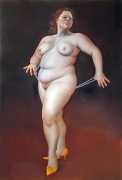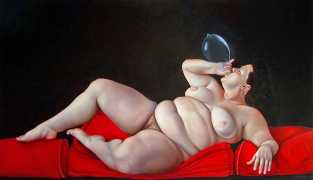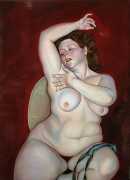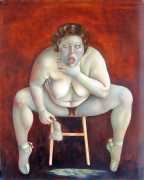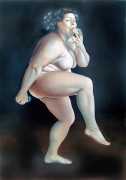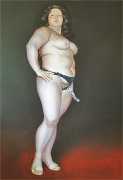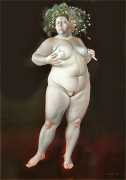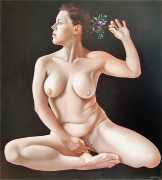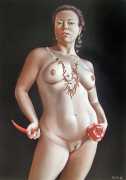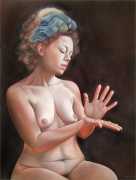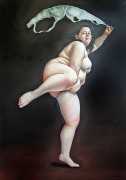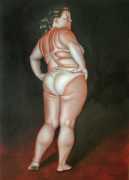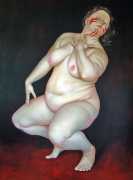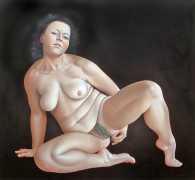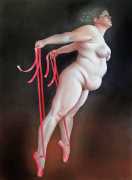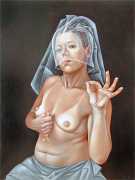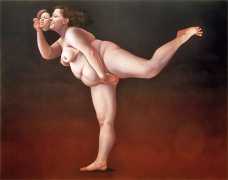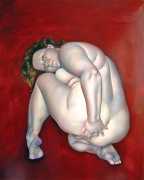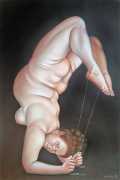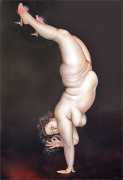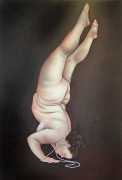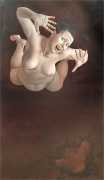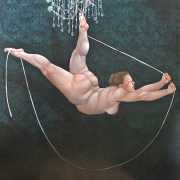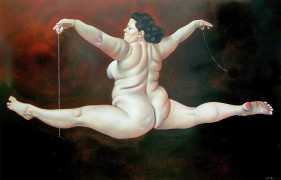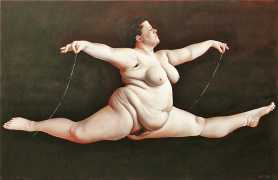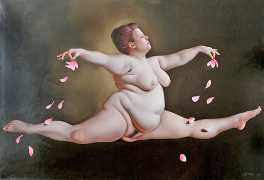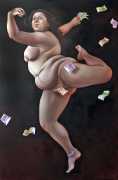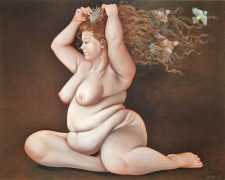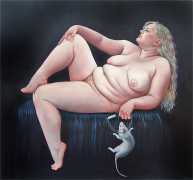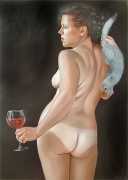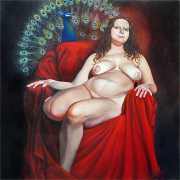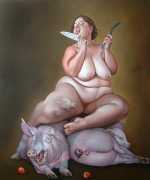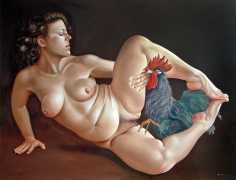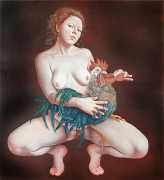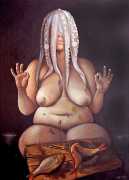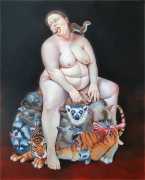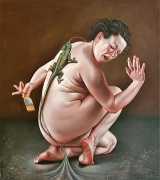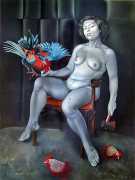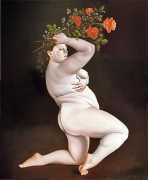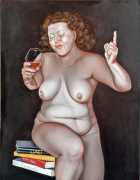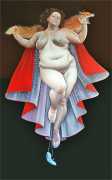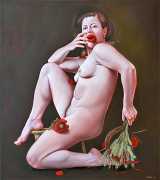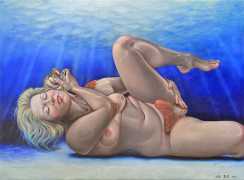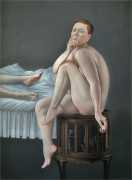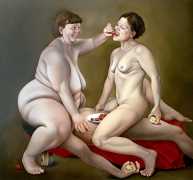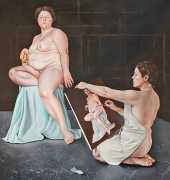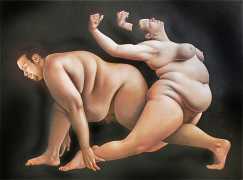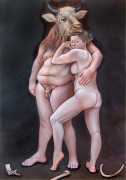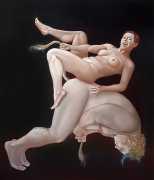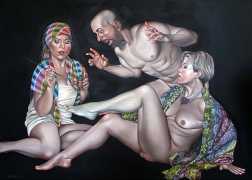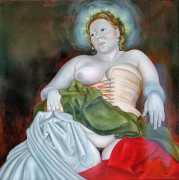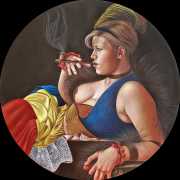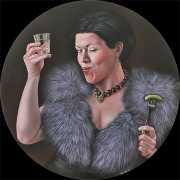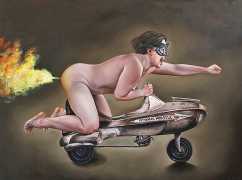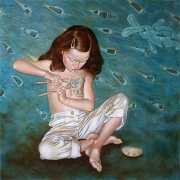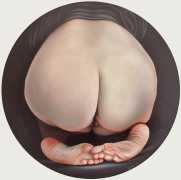Lilly Hill’s website has a link to an article written for the Transartis online magazine; you can read it in full (in German) here; we have extracted some of the most interesting parts.
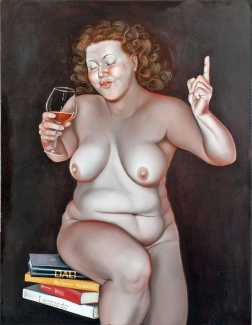 Only upon superficial inspection could Lilly Hill's paintings be reduced to a single, clearly identifiable statement. It is the seductive power of the carnal that initially completely captivates the eye, because in her large format paintings the artist sensually and very freely presents her own body, which in no way corresponds to today’s emphasis on slimness. The exuberant sensuality of abundant flesh in Lilly Hill’s paintings not only advocates for a less rigid body image – it is about presenting the naked, fully-exposed female body for visual consumption whatever it looks like.
Only upon superficial inspection could Lilly Hill's paintings be reduced to a single, clearly identifiable statement. It is the seductive power of the carnal that initially completely captivates the eye, because in her large format paintings the artist sensually and very freely presents her own body, which in no way corresponds to today’s emphasis on slimness. The exuberant sensuality of abundant flesh in Lilly Hill’s paintings not only advocates for a less rigid body image – it is about presenting the naked, fully-exposed female body for visual consumption whatever it looks like.
With her art, Lilly Hill walks the fine line of pornographic-looking productions that aim to satisfy the voyeuristic gaze of a mostly male desire. However, the sensual approach to one’s own carnal desire, as depicted in her paintings, is far too self-determined to fulfil the hierarchical relationship of the pornographic representation. Here the female body is by no means degraded to a disposable object and commodity, but rather is presented predominantly from below, so that Lilly Hill’s self-stagings appear as potent as they are self-evident. Not without a subtle ironic undertone, the artist allows us to share in her self-centred preoccupation with her body, for example when she counteracts heavy physicality with a balancing act through a wafer-thin thread. Her gaze meets us with a challenge as she enjoys exploring her own body. It is with self-assertion and pride, detachment and defiance, that she looks at not only at us, but also at herself.
Before she starts painting, Lilly Hill creates photographic self-portraits with the help of mirrors, transformed in her painting into fascinating and disturbing explorations of her own body. The unadorned presentation of her own body is reminiscent of the paintings of Lucian Freud, who no less vividly demonstrates the sensual power of the physical in his paintings, but while Freud brings the substantiality of the material colour onto the canvas in such a way that the material nature of the body becomes tangible, Lilly Hill on the other hand sublimates her own voluminous physicality through the technique of glazing. Colour effects are traditionally used in such a way that the materiality of things is merely evoked, without the materiality of the colour itself coming into consciousness. This is why her naked body is not overwhelmed by the brutal exposure of its ugliness, as in Freud, but appears extraordinarily aesthetic in its fleshly presence.
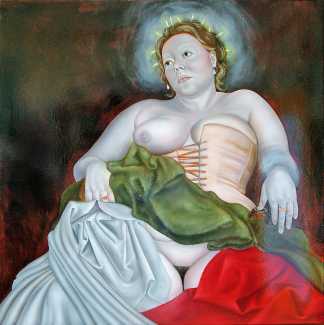 There is a disturbing beauty that emanates from Lilly Hill’s painting, which is largely based on the artist’s wide knowledge of citing art historical models that have entered our collective visual memory. If you look at the paintings more closely, the gestures, poses and staging appear strangely familiar. A striking example is a self-portrait from 2005 titled ‘Maria’. The figure’s upward gaze evokes depictions of ecstatic figures of saints from the Renaissance, while the chain of lights in the hair acts like a radiant nimbus on the one hand. The breast protruding above the tightly laced corsage also evokes classical representations of Maria lactans, images of the Virgin Mary nurturing motherhood by highlighting the breast nursing the baby Jesus. In Hill’s painting the exposed breast is balanced by the other, concealed by elaborately draped cloths and a valuable fur, reminiscent of Leopold von Sacher-Masoch’s Venus in Furs.
There is a disturbing beauty that emanates from Lilly Hill’s painting, which is largely based on the artist’s wide knowledge of citing art historical models that have entered our collective visual memory. If you look at the paintings more closely, the gestures, poses and staging appear strangely familiar. A striking example is a self-portrait from 2005 titled ‘Maria’. The figure’s upward gaze evokes depictions of ecstatic figures of saints from the Renaissance, while the chain of lights in the hair acts like a radiant nimbus on the one hand. The breast protruding above the tightly laced corsage also evokes classical representations of Maria lactans, images of the Virgin Mary nurturing motherhood by highlighting the breast nursing the baby Jesus. In Hill’s painting the exposed breast is balanced by the other, concealed by elaborately draped cloths and a valuable fur, reminiscent of Leopold von Sacher-Masoch’s Venus in Furs.


